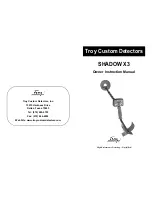
Ramsey Oretronic IV Tramp Metal Detector REC 4479C
Page 63
The receive coil is supposed to be mounted in a certain direction with respect to the direction of belt travel.
There is a label on the coil assembly showing the correct orientation. In this orientation, tramp travelling
through the coils will produce a positive pulse and then a negative pulse. If the receive coils have been
mounted incorrectly, set this parameter to have the software compensate for the error.
Clip Detection Enabled
Base Address:
H1601
Type:
UINT16
Access:
Get/Set
Length:
N/A
Persistent:
Yes
Min:
0
Max:
1
This parameter can be used to enable or disable the clip detection feature. When the feature is disabled the
clip detector inputs are ignored.
Bar Rod Detection Enabled
Base Address:
H1617
Type:
UINT16
Access:
Get/Set
Length:
N/A
Persistent:
Yes
Min:
0
Max:
1
This parameter is a flag which turns the Bar/Rod detection feature on and off.
Bar Rod Length
Base Address:
H1633
Type:
FLOAT
Access:
Get/Set
Length:
N/A
Persistent:
Yes
Min:
1
Units:
Meters
Max:
15.24
Default:
15.24
The maximum bar length that can be detected by the bar/rod detection feature. The bar/rod detection
algorithm will detect bars between 0.46 meters and this length.
Bar Rod Sensitivity
Base Address:
H1649
Type:
UINT16
Access:
Get/Set
Length:
N/A
Persistent:
Yes
Min:
1
Units
Unit-less
Max:
9
This item specifies the “sensitivity” value for the bar/rod algorithm. The bar/rod detection algorithm has its
own signal threshold. The bar/rod threshold is a fraction of the threshold used by the normal detection
algorithm. The fraction corresponding to each setting of this parameter is given in the table below.
Value
Fraction
1
1
2
15/16
3
14/16





































